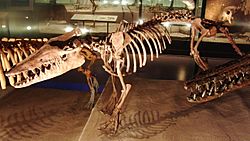Pakicetus facts for kids
Quick facts for kids PakicetusTemporal range: early Eocene, 49–33.9 mya
|
|
|---|---|
 |
|
| Scientific classification | |
| Domain: | |
| Kingdom: | |
| Class: | |
| Order: | |
| Suborder: | |
| Family: |
Pakicetidae
|
| Genus: |
Pakicetus
|
| Binomial name | |
| Pakicetus inachus |
|
Pakicetus is a genus of extinct cetaceans found in the early Eocene of Pakistan 55.8 ± 0.2 - 33.9 ± 0.1 million years ago (mya). The strata where the fossils were found was then on the coast of the Tethys Sea.
Description
The first fossil, a lone skull, was thought to be a mesonychid, but Gingerich and Russell recognized it as an early cetacean. It had characteristics of the inner ear which are found only in cetaceans: the large auditory bulla is formed from the ectotympanic bone only. This suggests that it is a transitional species between extinct land mammals and modern cetaceans.
Complete skeletons were discovered in 2001. Pakicetus was mainly a land animal, about the size of a wolf, and very similar in form to the related mesonychids.
Images for kids
See also
 In Spanish: Pakicetus para niños
In Spanish: Pakicetus para niños


